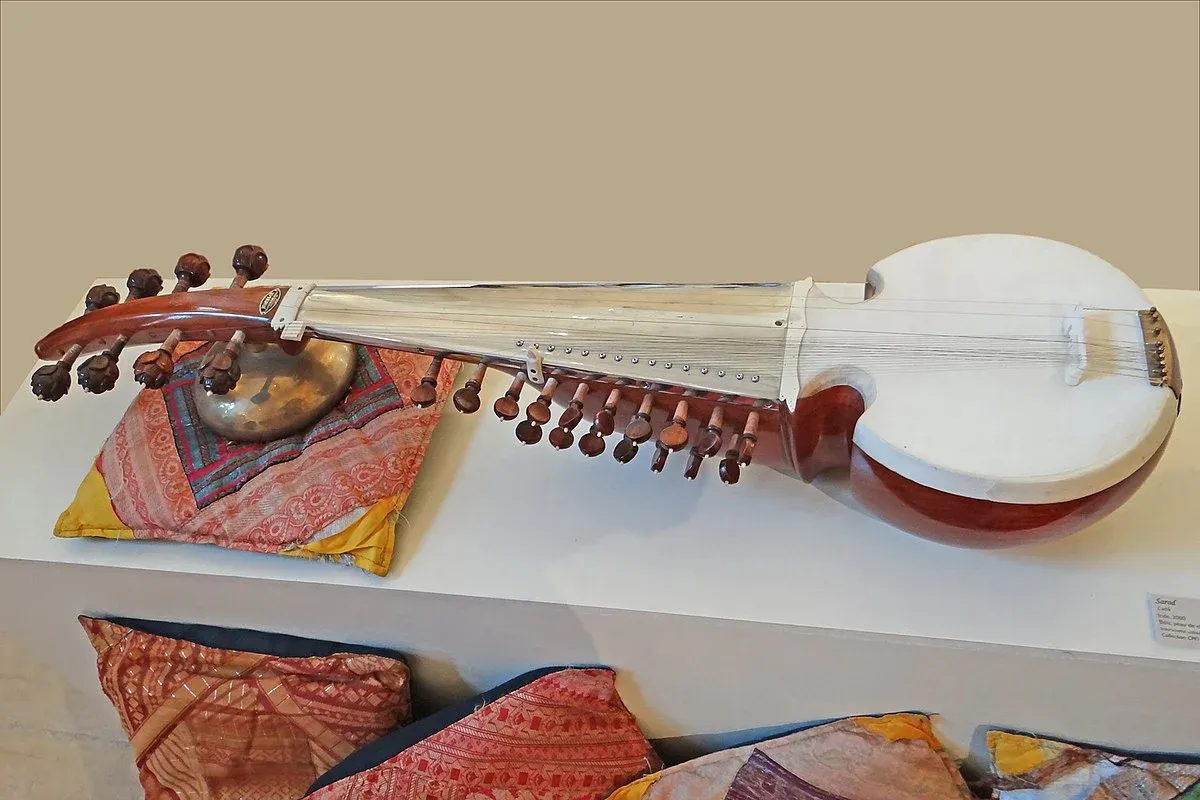About Sarod:
- It is a stringed instrument in the lute family and one of the most popular instruments in Hindustani classical music.
- It is often accompanied by the tabla (drums) and tambura (drone lute).
- It is an adaptation of the Afghan rabab, which arrived in India during the 16th century.
- The modern form of the instrument was designed in the 19th century.
- Design:
- The sarod is 100 cm long and has a body made from hollow teak, sagwan, or tun wood.
- High-quality instruments have a body, neck, and peg box made from a single piece of wood.
- The resonator has a stretched membrane (usually goatskin) and a bridge made from horn where the strings rest.
- The bridge is very thin, like that of a violin. The melody strings are stretched across the bridge, and the sympathetic strings run through holes drilled into the bridge.
- The strings were traditionally made from gut or silk, but today areusually made from steel or bronze.
- The neck of the instrument does not have a fretboard, but rather a polished, steel plate.
- Playing:
- One who plays the sarod is called a sarodiya, and the word sarod is Persian for song or melody.
- The seated player holds the instrument across his lap.
- The strings of the sarod are plucked using a triangle-shaped plectrum called a jawa, usually made from coconut shell, ebony, or horn., while the fingernails of the left hand press the strings.
Two prominent Indian schools of sarod playing are those of Ghulam Ali Khan and Allauddin Khan, each with its own playing style, type of sarod (e.g., size, shape, and number of strings vary), and tuning system.
Q1: What is tambura?
The tambura or tanpura is a plucked drone instrument used to accompany instrumental or vocal performances. It has a hollow neck, measures about 40–60 inches (102–153 cm) in length, and usually has four metal strings tuned.It resembles the tanbur, the Middle Eastern lute from which it derives.
Source: Sarod maestro Pandit Rajeev Taranath passes away
Last updated on November, 2025
→ Check out the latest UPSC Syllabus 2026 here.
→ Join Vajiram & Ravi’s Interview Guidance Programme for expert help to crack your final UPSC stage.
→ UPSC Mains Result 2025 is now out.
→ UPSC Notification 2026 is scheduled to be released on January 14, 2026.
→ UPSC Calendar 2026 is released on 15th May, 2025.
→ The UPSC Vacancy 2025 were released 1129, out of which 979 were for UPSC CSE and remaining 150 are for UPSC IFoS.
→ UPSC Prelims 2026 will be conducted on 24th May, 2026 & UPSC Mains 2026 will be conducted on 21st August 2026.
→ The UPSC Selection Process is of 3 stages-Prelims, Mains and Interview.
→ UPSC Result 2024 is released with latest UPSC Marksheet 2024. Check Now!
→ UPSC Prelims Result 2025 is out now for the CSE held on 25 May 2025.
→ UPSC Toppers List 2024 is released now. Shakti Dubey is UPSC AIR 1 2024 Topper.
→ UPSC Prelims Question Paper 2025 and Unofficial Prelims Answer Key 2025 are available now.
→ UPSC Mains Question Paper 2025 is out for Essay, GS 1, 2, 3 & GS 4.
→ UPSC Mains Indian Language Question Paper 2025 is now out.
→ UPSC Mains Optional Question Paper 2025 is now out.
→ Also check Best IAS Coaching in Delhi

















